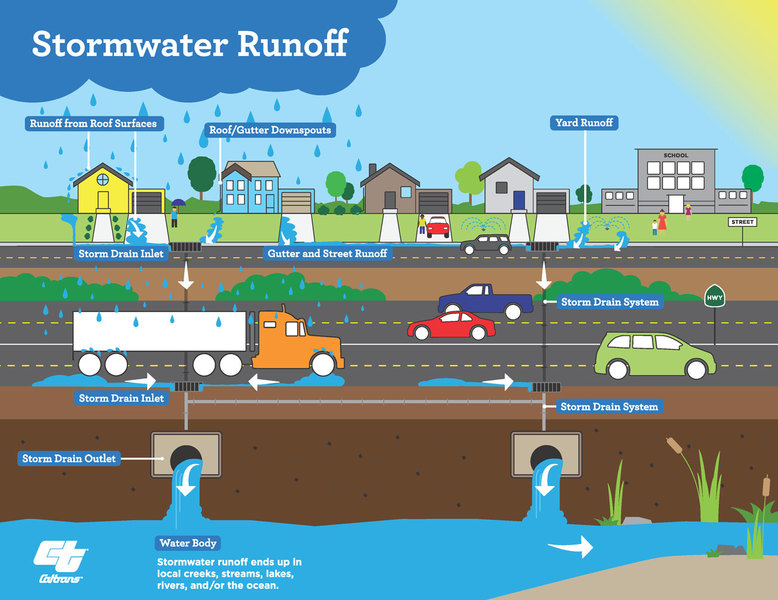Over a Friday morning Zoom call in early August, I received a crash course in stormwater regulations. I was speaking with Courteny Morehouse, an environmental planner with the Berkshire Regional Planning Commission in Massachusetts. Courteny supports communities in Western Massachusetts with understanding and working with regional and federal stormwater programs. She's incredibly knowledgeable about stormwater management, so she had plenty to share when I asked her the question, "What do you want people to know about stormwater?"
The summary below is based on our conversation, which started with a brief history of water quality regulations in the US and landed on what residents can do to help prevent wastewater and stormwater pollution in their communities.
The US Clean Water Act begins by regulating industrial point source pollution
The Clean Water Act of 1972 was the first time the US made a comprehensive resolution that regulated industrial point sources of water pollution. If an industrial facility, wastewater treatment plant, or other identifiable source discharges pollutants into the country's navigable waters, it needs a permit. The National Pollutant Discharge Elimination System (NPDES, or "nip-dees" in stormwater circles, as Courteny shared) was created to control these discharges and the federal government allowed individual states and tribes to implement the program.

Wastewater treatment plant in Portland, OR. Eli Duke, CC BY SA
Some states did better at upholding the program than others. But across the country, the original NPDES regulations didn't do a great job of reducing nonpoint source pollution. This kind of water pollution comes from many different places at many different times, rather than a specific identifiable source. In urban areas, nonpoint sources include stormwater from rain and surface runoff that flows from roadways, construction sites, and roofs into storm drains. In more rural areas, nonpoint sources commonly include agricultural land, mining activities, or failing septic systems. If the water isn't treated before it enters local waterways, it brings along pollutants from these nonpoint sources as it moves over and underground. Two decades after the NPDES program was created, the Environmental Protection Agency declared that nonpoint sources were the biggest source of remaining water pollution in the US.
Controlling nonpoint source water pollution
In an effort to regulate these diffuse sources of water pollution, the EPA stated that it would consider certain collections of nonpoint sources as a single point source.
For example, an entire urbanized area could be considered a point source. All the untreated stormwater discharges coming from a city would then be covered under a NPDES permit. Areas even more diffuse than cities could be considered point sources, too. The Massachusetts Department of Transportation, for instance, has a NPDES permit that covers roadways, drainage systems, and other infrastructure that MassDOT oversees.
These updated regulations covered places with Municipal Separate Storm Sewer Systems (MS4). An MS4 collects and transports untreated stormwater to waterways via storm drains, pipes, and ditches. A separate sanitary sewer system directs sewage to wastewater treatment plants where it's treated before being released into the environment. Places with MS4 permits under NPDES are required to follow several provisions to reduce nonpoint source water pollution.

Nonpoint sources of water pollution. From the Caltrans website, public domain.
Knowing where wastewater goes
One of the most impactful points that Courteny raised during our conversation was about the persistent mentality to simply send used water away. Historically, societies have built infrastructure that's designed to dump wastewater directly into otherwise clean waterways. And even with the development of sewer systems and wastewater treatment, elements of that approach still exist today. Confined within pipes and ditches, wastewater is a problem we don't often see for ourselves.
What community members can do
Here are some tips from Courteny about what community members can do to help improve their local water quality:
- Assume that wherever you are, you are in someone's watershed.
- Learn about things you can do to help prevent polluted stormwater from entering local waterways. There's a great resource here from the Greater Lansing Regional Committee for Stormwater Management website, and more tips here from the EPA. Public Lab also has some guidance on community advocacy here.
- Report problems with stormwater pollution to local agencies so they can find and fix the issue. We've outlined the steps in an activity here!
- Learn about the health of waterways near you. We've outlined the steps in another activity here!
- Ask your local representatives about applying for Clean Water Act funding for local projects:
- The 604(b) Water Quality Program can provide regional funds for water quality management and infrastructure
- The 319 Grant Program for States and Territories can support nonpoint source pollution reduction projects. For example, a grant could fund building green infrastructure for stormwater management, like bioswales.
"What is wastewater and how do we keep it clean?" from RE Sources for Sustainable Communities
Find out more
- Basic Information about Nonpoint Source (NPS) Pollution
- The MS4 program under NPDES
- The six minimum control measures that MS4 permits require

0 Comments
Login to comment.